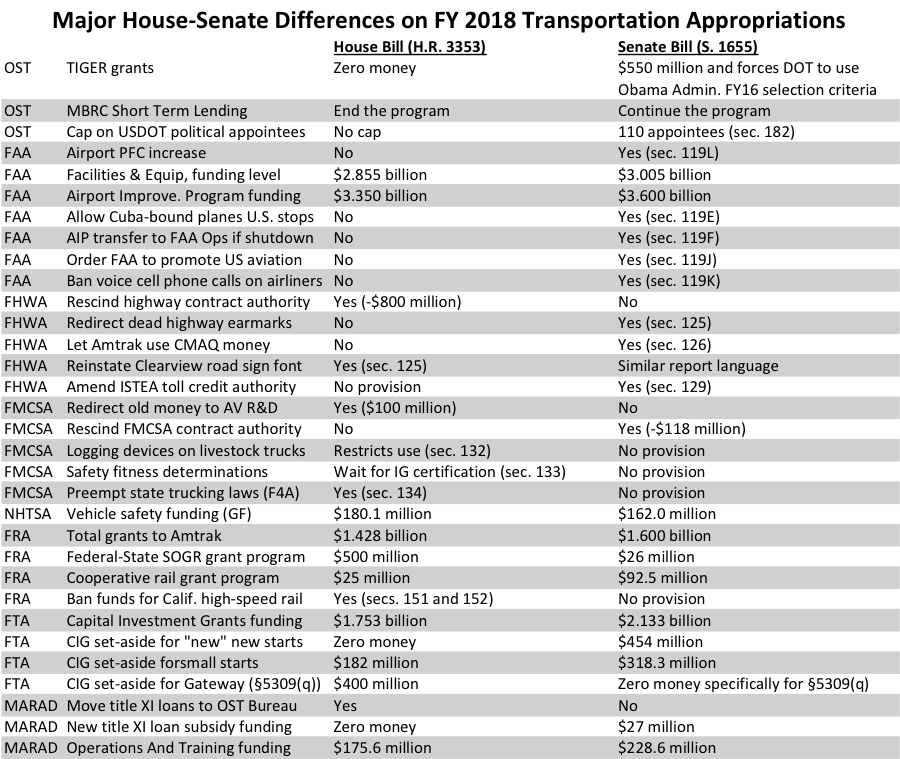March 16, 2018
Hopes that the House could pass a final $1.3 trillion omnibus appropriations package for fiscal year 2018 this week were dashed by a small number of unresolved issues, foremost among them whether or not to give an initial tranche of money towards the $30 billion Gateway program of rail projects in New York and New Jersey, the centerpiece of which is a new $13 billion tunnel project beneath the Hudson River.
Negotiators now hope to file the legislation and post the text of the legislation on Monday, allowing a House vote Tuesday and (hopefully) giving the Senate time to debate and pass the bill before government funding expires at midnight on Friday, March 23.
But the Gateway issue remains unsolved. House Speaker Paul Ryan (R-WI) reportedly told a group of New York and New Jersey Republican lawmakers this week that the House just can’t pass an appropriations bill that the President will veto, and that President Trump has personally asked Ryan on no less than four separate occasions to take the Gateway money out of the omnibus appropriations package. A few other issues, mostly relating to legislative language (not dollar amounts), remain unresolved as well.
(For more info on the Gateway program, click here.)
The House version of the Transportation-HUD appropriations bill puts a down payment of $900 million towards Gateway projects without actually violating Congress’s internal ban on earmarks. This was primarily at the behest of chairman Rodney Frelinghuysen (D-NJ). The Senate bill does not direct any funding towards Gateway specifically.
But the words “Gateway” or “Hudson River Tunnel” appear nowhere in the House bill, however. Instead, the $900 million appears in two separate slugs of money in appropriations for broader grant programs. First, at the Federal Railroad Administration:
For necessary expenses related to Federal-State Partnership for State of Good Repair grants as authorized by section 24911 of title 49, United States Code, $500,000,000, to remain available until expended: Provided…That in selecting an applicant for a grant, the Secretary shall first give preference to eligible projects for which the environmental impact statement required under the National Environmental Policy Act and design work is already complete at the time of the grant application review, or to projects that address major critical assets which have conditions that pose a substantial risk now or in the future to the reliability of train service.
The Portal North Bridge project, part of Gateway, has had its EIS and design work completed for years, and the “critical asset” part of the last proviso is clearly meant to address the Hudson River Tunnel.
The other $400 million is a set-aside in the Federal Transit Administration’s Capital Investment Grants program (emphasis added):
For necessary expenses to carry out 49 U.S.C. 5309, $1,752,989,851, to remain available until expended, of which $1,007,929,851 shall be available for projects authorized under section 5309(d) of title 49, United States Code, $145,700,000 shall be available for projects authorized under section 5309(e) of such title, $182,000,000 shall be available for projects authorized under section 5309(h) of the title, and $400,000,000 shall be available for projects authorized under section 5309(q): Provided, That the Secretary shall continue to administer the Capital Investment Grant Program in accordance with the procedural and substantive requirements of section 5309 of title 49.
Subsection (q) of section 5309 is a set-aside for “grants for new fixed guideway capital projects and core capacity improvement projects that provide both public transportation and intercity passenger rail service”.
Normally, when negotiating a House-Senate agreement on an appropriations bill, the universe of eventual outcomes is somewhere between the House number and the Senate number. But this year, things may be different, because the bipartisan budget deal signed into law floods the appropriators with extra money. As the table below shows, the House appropriators wrote bills that totaled $511 billion in non-defense spending and the Senate appropriators wrote to $519 billion. But instead of compromising between $511 billion and $519 billion (President Trump had proposed $462 billion), they compromised at $579 billion.
Non-Defense Appropriations
|
| House Bills |
$510.7 billion |
| Senate Bills |
$518.5 billion |
| Final – Omnibus |
$579.0 billion |
| Omni vs. House |
+$68.3 billion |
| Omni vs. Senate |
+$60.5 billion |
We don’t know how much money the appropriators tentatively decided to put towards Gateway in the final package – it could be less than the House’s $900 million, but it could be more. But if the President is successful in forcing Gateway money to be pulled from this bill, it is an open question where that money would go – would it be redistributed to other accounts in the Transportation-HUD bill, or would it be given to another subcommittee? There are also political concerns – if Gateway goes, Democrats (and Frelinghuysen and some other NY/NJ Republicans) are threatening to walk away from the bill. Some other incentive would have to be given to them to get them back on board.
The table below shows the current totals for all of the House-passed and Senate-reported FY18 appropriations bills. (As part of “Appropriations – The Home Game,” ETW readers can fill in the blanks and guess how much money each subcommittee will finally receive.

Within the Transportation-HUD bill, there are plenty of other differences as well. For the financial differences, we can expect those to be resolved at the higher end of the House-Senate differences or perhaps higher than either chamber. For example, there is now no longer any need for the House’s $800 million rescission of highway contract authority, which was only necessary because of the low spending number originally assigned to the bill, so we can expect that to be dropped. For TIGER, transit new starts, and Amtrak, we can expect the higher of the House or Senate numbers (and maybe much higher, who knows).
For the non-financial House-Senate differences it is a different story. The fact that House Transportation and Infrastructure chairman Bill Shuster (R-PA) has decided to drop his insistence on breaking up the FAA and spinning off air traffic control services to a private, non-profit corporation (the Canada model) means that the House will consider a FAA reauthorization bill in the coming weeks. Shuster has made a strong case to House leaders that it is his bill, and not the appropriations bill, that should be the proper forum for the half-dozen aviation policy issues in the Senate appropriations bill, most of which are amendments to title 49 of the United States Code and thus squarely within authorizing committee, and not appropriations, jurisdiction.
For the last several years, the question of whether or not to clarify that federal law preempts state law relating to the meal and rest breaks of intrastate (not interstate) truckers, which is an issue in the states covered by the U.S. Court of Appeals for the Ninth Circuit, which has ruled otherwise on a California law. This “F4A” provision is a top priority of the trucking industry and is in the House bill. It was an issue in contention when Congress was passing the FAST Act surface transportation law in 2015, but opposition by Senator Barbara Boxer (D-CA) killed it. Similarly, House Democratic Leader Nancy Pelosi (D-CA) opposes the F4A federal preemption language. The issue is still believed to be unsolved in the FY18 omnibus.
The table below shows most of the main differences between the House and Senate transportation appropriations titles in the FY18 Transportation-HUD bill.






